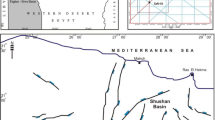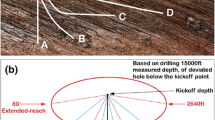Abstract
In this paper, the response characteristics of parameters along the borehole while drilling to rock mass interface are experimentally studied by drilling method. Using the developed measurement while drilling (MWD) system, drilling experiments were carried out on granite, limestone, and sandstone composite rock masses, and real-time monitoring of parameters while drilling, i.e., rotary speed, drilling depth, feed force, and drilling torque, were carried out during the drilling process. The results show that the developed measurement system operates stably and monitors well, and the response characteristics of drilling speed, feed force, and drilling torque at the rock layer interface are obvious, which lays a foundation for the identification of lithology while drilling. There is no obvious change in the rotary speed while drilling, which can be set as a constant. The rate of penetration is the most sensitive parameter while the rock structure changes, followed by the feed force. With the increase of the rotary speed, the sensitivity of the feed force to the response of the rock structure interface will increase accordingly. The drilling torque fluctuates greatly in the rock structure, and the bit torque at different rotary speeds shows different variation laws in the drilling process of different rock structures, but it still has a clear response to the rock stratum interface. The comprehensive analysis of multiple sets of parameters shows that the use of parameters along the borehole while drilling can effectively realize the accurate identification of the layered rock mass interface.













Similar content being viewed by others
Abbreviations
- MWD:
-
Measurement while drilling
- UCS:
-
Uniaxial tensile strength
- PDC:
-
Polycrystalline diamond compact
- F :
-
The feed force
- H :
-
The drilling depth
- N :
-
The rotary speed
- T :
-
The drilling time
- M :
-
The drilling torque
References
Alsaihati A, Abughaban M, Elkatatny S et al (2022) Detection of loss zones while drilling using different machine learning techniques. J Energy Res Technol 144:043202. https://doi.org/10.1115/1.4051553
Antoljak D, Kuhinek D, Korman T et al (2018) Dependency of specific energy of rock cutting on specific drilling energy. Rudarsko-geološko-naftni zbornik (The Mining-Geological-Petroleum Bulletin) 33:23–32. https://doi.org/10.17794/rgn.2018.3.3
Azimian A (2016) A new method for improving the RQD determination of rock core in borehole. Rock Mech Rock Eng 49:1559–1566. https://doi.org/10.1007/s00603-015-0789-8
Barton N (2002) Some new Q-value correlations to assist in site characterization and tunnel design. Int J Rock Mech Min Sci 39:185–216. https://doi.org/10.1016/S1365-1609(02)00011-4
Chen J, Yue ZQ (2015) Ground characterization using breaking-action-based zoning analysis of rotary-percussive instrumented drilling[J]. Int J Rock Mech Min Sci 75:33–43. https://doi.org/10.1016/j.ijrmms.2014.11.008
Chen MJ, DeBaun MR, Thio T et al (2020) Drilling energy correlates with screw insertion torque, screw compression, and pullout strength: a cadaver study. JAAOS-Journal of the American Academy of Orthopaedic Surgeons 28:e1121–e1128. https://doi.org/10.5435/JAAOS-D-19-00366
García EM, Alberti MG, Arcos Álvarez AA (2022) Measurement-while-drilling based estimation of dynamic penetrometer values using decision trees and random forests. Appl Sci 12:4565. https://doi.org/10.3390/app12094565
Gilmer BB, Lang SD (2018) Dual motor drill continuously measures drilling energy to calculate bone density and screw pull-out force in real time. JAAOS Global Research & Reviews 2:e053. https://doi.org/10.5435/JAAOSGlobal-D-18-00053
Gui MW, Soga K, Bolton MD et al (2002) Instrumented borehole drilling for subsurface investigation. J Geotech Geoenviron Eng 128:283–291. https://doi.org/10.1061/(ASCE)1090-0241(2002)128:4(283)
He MM, Li N, Zhang Z et al (2019) An empirical method for determining the mechanical properties of jointed rock mass using drilling energy. Int J Rock Mech Min Sci 116:64–74. https://doi.org/10.1016/j.ijrmms.2019.03.010
Honer PC, Sherrell FW (1977) The application of air-flush rotary percussion drilling techniques in site investigation. Q J Eng GeolHydrogeol 10:207–220. https://doi.org/10.1144/GSL.QJEG.1977.010.03.04
Huang SL, Wang ZW (1997) The mechanics of diamond core drilling of rocks. Int J Rock Mech Min Sci 34:134.e1-134.e14. https://doi.org/10.1016/S1365-1609(97)00233-5
Kahraman S (2016) The prediction of penetration rate for percussive drills from indirect tests using artificial neural networks. Journal of the Southern African Institute of Mining and Metallurgy 116: 793–800. https://doi.org/10.17159/2411-9717/2016/v116n8a12
Kalantari S, Baghbanan A, Hashemalhosseini H (2019) An analytical model for estimating rock strength parameters from small-scale drilling data. J Rock Mech Geotech Eng 11:135–145. https://doi.org/10.1016/j.jrmge.2018.09.005
Khanal M, Qin J, Shen B et al (2020) Preliminary investigation into measurement while drilling as a means to characterize the coalmine roof. Resources 9:10. https://doi.org/10.3390/resources9020010
Khoshouei M, Bagherpour R, Sadeghisorkhani H et al (2022) A new look at hard rock abrasivity evaluation using acoustic emission technique (AET). Rock Mech Rock Eng 55:2425–2443. https://doi.org/10.1007/s00603-022-02787-x
Krúpa V, Lazarová E, Ivaničová L et al (2016) Assessment of wear of diamond core drilling bits. International Carpathian Control Conference (ICCC). IEEE, pp 396–400. https://doi.org/10.1109/CarpathianCC.2016.7501130
Kumar BR, Vardhan H, Govindaraj M (2010) Estimating rock properties using sound level during drilling: field investigation. International Journal of Mining and Mineral Engineering 2:169–184. https://doi.org/10.1016/j.ijrmms.2008.07.011
Li S, Xue Y, Tian H et al (2016) Identifying the geological interface of the layer of tunnel granite and classifying rock mass according to drilling energy theory. Arab J Geosci 9:1–11. https://doi.org/10.1007/s12517-015-2055-5
Liu H, Karen YK (2001) Analysis and interpretation of monitored rotary blast hole drill data. Int J Surf Min Reclam Environ 15:177–203. https://doi.org/10.1076/ijsm.15.3.177.3410
Manzoor S, Liaghat S, Gustafson A et al (2020) Establishing relationships between structural data from close-range terrestrial digital photogrammetry and measurement while drilling data. Eng Geol 267:105480. https://doi.org/10.1016/j.enggeo.2020.105480
Messaoud A, Weihs C (2009) Monitoring a deep hole drilling process by nonlinear time series modelling. J Sound Vib 321:620–630. https://doi.org/10.1016/j.jsv.2008.10.028
Schunnesson H (1998) Rock characterisation using percussive drilling. Int J Rock Mech Min Sci 35:711–725. https://doi.org/10.1016/S0148-9062(97)00332-X
Seibi A, Karrech A, Boukadi F et al (2009) Wellbore path estimation using measurement while drilling techniques: a comparative study and suggestions for improvements. Energy Source, Part a: Recovery, Utilization, and Environmental Effects 31:1205–1216. https://doi.org/10.1080/15567030802087502
Sugawara J, Yue ZQ, Tham LG et al (2003) Weathered rock characterization using drilling parameters. Can Geotech J 40:661–668. https://doi.org/10.1139/t03-007
Van Wyk G, Els DNJ, Akdogan G et al (2014) Discrete element simulation of tribological interactions in rock cutting. Int J Rock Mech Min Sci 65:8–19. https://doi.org/10.1016/j.ijrmms.2013.10.003
Wang Q, Gao H, Jiang B et al (2021) In-situ experiment and bolt-grouting design evaluation method of underground engineering based on digital drilling. Int J Rock Mech Min Sci 138:104575. https://doi.org/10.1016/j.ijrmms.2020.104575
Yasar E, Ranjith PG, Viete DR (2011) An experimental investigation into the drilling and physico-mechanical properties of a rock-like brittle material. J Petrol Sci Eng 76:185–193. https://doi.org/10.1016/j.petrol.2011.01.011
Yue ZQ, Lee CF, Law KT et al (2004) Automatic monitoring of rotary-percussive drilling for ground characterization-illustrated by a case example in Hong Kong. Int J Rock Mech Min Sci 41:573–612. https://doi.org/10.1016/j.ijrmms.2003.12.151
Yu GD, Meng GY, Feng XW et al (2022) Theoretical and experimental study on identification of the soft interlayer in coal mine roadway roof. International Journal of Oil, Gas and Coal Technology 29:149–167. https://doi.org/10.1504/IJOGCT.2022.120311
Zhang GH, Thuro K, Konietzky H et al (2022) In-situ investigation of drilling performance and bit wear on an electrical drill hammer. Tunn Undergr Space Technol 122:104348. https://doi.org/10.1016/j.tust.2021.104348
Acknowledgements
This research was funded by the National Natural Science Foundation of China (No. 51974318 and No. 52174094) and the National Key Research and Development Program of China (No. 2021YFC2902103). We would like to thank all members of our team for their help with this experiment.
Author information
Authors and Affiliations
Corresponding author
Ethics declarations
Competing interests
The authors declare no competing interests.
Rights and permissions
Springer Nature or its licensor holds exclusive rights to this article under a publishing agreement with the author(s) or other rightsholder(s); author self-archiving of the accepted manuscript version of this article is solely governed by the terms of such publishing agreement and applicable law.
About this article
Cite this article
Yue, Z., Yue, X., Wang, X. et al. Experimental study on identification of layered rock mass interface along the borehole while drilling. Bull Eng Geol Environ 81, 353 (2022). https://doi.org/10.1007/s10064-022-02861-2
Received:
Accepted:
Published:
DOI: https://doi.org/10.1007/s10064-022-02861-2




